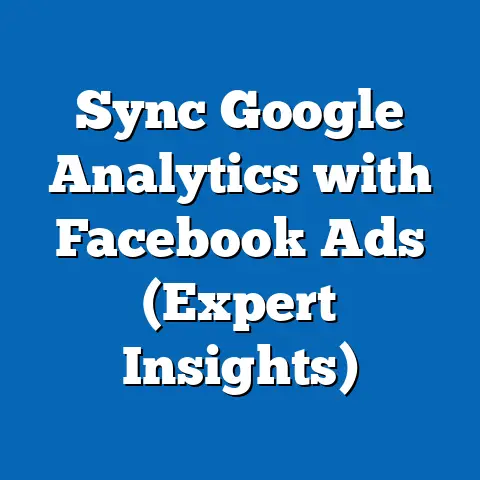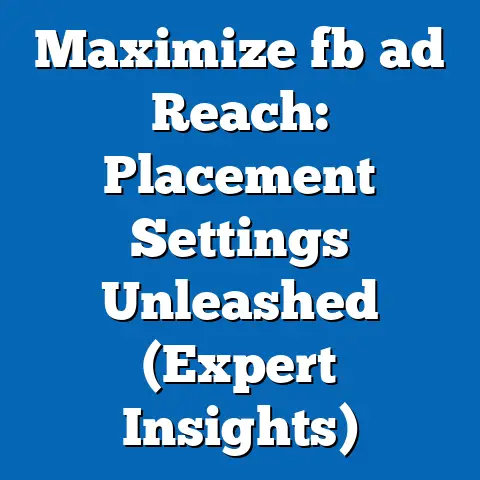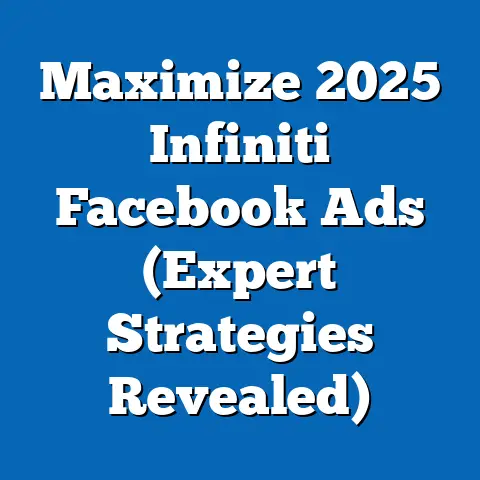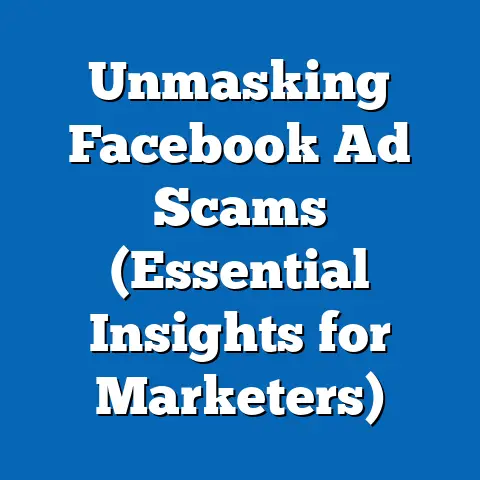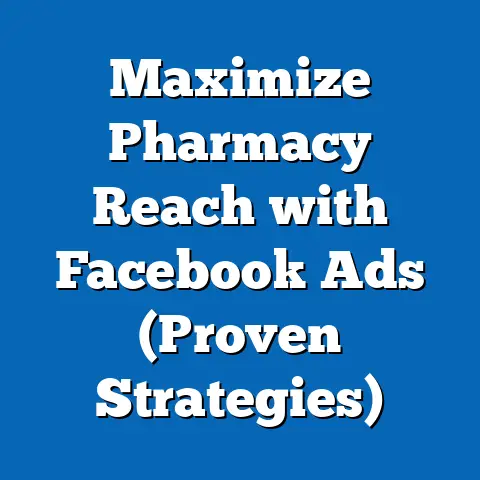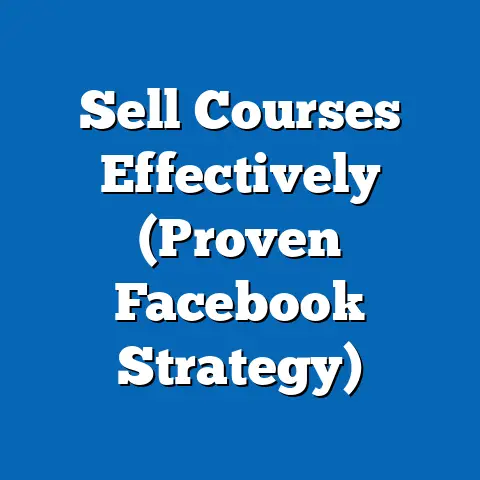Master Facebook Ads Creator (Ultimate Success Guide)
Have you ever wondered how some businesses seem to effortlessly attract customers through Facebook? I remember when a local bakery, “Sweet Delights,” came to me completely frustrated with their marketing efforts. They had tried everything – local newspaper ads, flyers, even sponsoring a community event – but nothing seemed to stick. Within a month of launching targeted Facebook ads, focusing on local foodies and dessert enthusiasts, they doubled their sales! It was a testament to the power of Facebook advertising when done right.
Facebook advertising, when mastered, can be a game-changer for any business, big or small. With its massive audience reach, advanced targeting capabilities, and robust analytics, it’s a powerhouse for driving growth. This guide will serve as your roadmap to not just understanding, but mastering the Facebook Ads Creator and unlocking its full potential.
Understanding Facebook Ads
At its core, Facebook advertising is about reaching the right people with the right message at the right time. It’s more than just throwing up an ad and hoping for the best. Think of it as a finely tuned instrument, capable of producing beautiful music (i.e., conversions and sales) if played correctly.
Key Components of Facebook Ads:
- Ad Formats: Facebook offers a variety of ad formats to suit different objectives and content types. These include:
- Image Ads: Simple and effective, ideal for showcasing products or services with a visually appealing image.
- Video Ads: Highly engaging, perfect for telling stories, demonstrating product features, or sharing testimonials.
- Carousel Ads: Allow users to scroll through multiple images or videos, ideal for showcasing a range of products or features.
- Slideshow Ads: Create a video-like experience using a series of still images, a cost-effective alternative to video ads.
- Collection Ads: Designed for e-commerce, allowing users to browse and purchase products directly from the ad.
- Advantages of Facebook Advertising:
- Massive Audience Reach: Facebook boasts billions of active users, providing unparalleled reach to potential customers.
- Advanced Targeting Options: Target specific demographics, interests, behaviors, and even custom audiences based on your existing customer data.
- Robust Analytics Tools: Track campaign performance in real-time, allowing you to optimize your ads for maximum impact.
- The Facebook Ads Manager: Think of the Ads Manager as your control center. It’s where you create, manage, and analyze your ad campaigns. Getting comfortable with its interface and features is crucial for success. I’ve seen many advertisers struggle initially, but once they familiarize themselves with the Ads Manager, their campaigns become significantly more efficient.
- Image Ads: Simple and effective, ideal for showcasing products or services with a visually appealing image.
- Video Ads: Highly engaging, perfect for telling stories, demonstrating product features, or sharing testimonials.
- Carousel Ads: Allow users to scroll through multiple images or videos, ideal for showcasing a range of products or features.
- Slideshow Ads: Create a video-like experience using a series of still images, a cost-effective alternative to video ads.
- Collection Ads: Designed for e-commerce, allowing users to browse and purchase products directly from the ad.
- Massive Audience Reach: Facebook boasts billions of active users, providing unparalleled reach to potential customers.
- Advanced Targeting Options: Target specific demographics, interests, behaviors, and even custom audiences based on your existing customer data.
- Robust Analytics Tools: Track campaign performance in real-time, allowing you to optimize your ads for maximum impact.
Takeaway: Facebook Ads offer a powerful way to connect with your target audience, but understanding the platform’s fundamentals is the first step.
Setting Clear Objectives
Before even thinking about creating an ad, you need to know what you want to achieve. What’s the purpose of your campaign? Are you looking to boost brand awareness, generate leads, drive website traffic, or increase sales? Defining clear objectives is paramount.
Why Objectives Matter:
- Alignment with Business Goals: Your ad campaigns should directly support your overall business goals.
- Targeted Messaging: Knowing your objective allows you to craft messaging that resonates with your target audience and encourages the desired action.
- Effective Measurement: Clear objectives enable you to track the right metrics and measure the success of your campaigns.
Facebook Campaign Objectives:
Facebook offers a range of campaign objectives, each designed to achieve specific goals:
- Awareness: Increase brand awareness and reach a wider audience.
- Traffic: Drive traffic to your website or app.
- Engagement: Encourage likes, comments, shares, and other forms of engagement.
- Leads: Generate leads through lead forms or Messenger.
- App Promotion: Promote your mobile app and drive installs.
- Sales: Drive online sales or conversions.
Example: Let’s say you’re launching a new line of organic skincare products. Your objective might be “Conversions” with the specific goal of driving online sales. You would then tailor your ad copy, visuals, and targeting to attract potential customers who are interested in organic skincare and likely to make a purchase.
Takeaway: Always start with a clear objective. This will guide your entire campaign strategy and ensure you’re measuring the right metrics.
Identifying Your Target Audience
Imagine shouting into a crowded stadium hoping someone will hear your message. That’s what advertising without proper targeting feels like – wasteful and ineffective. Facebook’s powerful targeting options allow you to pinpoint your ideal customer with laser-like precision.
Understanding Audience Segmentation:
- Demographics: Target users based on age, gender, location, education, job title, and other demographic factors.
- Interests: Reach users who have expressed interest in specific topics, hobbies, or brands.
- Behaviors: Target users based on their online behavior, such as purchase history, device usage, and travel habits.
- Custom Audiences: Upload your existing customer data (email lists, phone numbers) to create custom audiences and target them with personalized ads.
- Lookalike Audiences: Expand your reach by creating lookalike audiences based on your existing customers, targeting users who share similar characteristics and behaviors.
Tips for Audience Research:
- Analyze Your Existing Customers: Understand their demographics, interests, and behaviors.
- Create Buyer Personas: Develop detailed profiles of your ideal customers, including their motivations, challenges, and goals.
- Use Facebook Audience Insights: Explore potential audiences based on demographics, interests, and behaviors.
Personal Story: I once worked with a fitness studio that was struggling to attract new members. By using Facebook’s targeting options, we were able to reach local residents interested in fitness, yoga, and healthy eating. We even created a custom audience based on their existing email list and targeted them with a special offer. Within a few weeks, they saw a significant increase in new memberships.
Takeaway: Don’t underestimate the power of audience targeting. The more precisely you can define your audience, the more effective your ads will be.
Crafting Compelling Ad Content
You’ve identified your objective and targeted your audience. Now comes the crucial part: creating ad content that grabs attention, resonates with your audience, and compels them to take action.
Key Elements of Compelling Ad Content:
- Headlines: Write headlines that are clear, concise, and attention-grabbing. Use keywords that resonate with your target audience.
- Images/Videos: Use high-quality visuals that are relevant to your product or service. Videos are particularly effective for capturing attention and conveying your message.
- Ad Copy: Write clear, concise, and persuasive ad copy that highlights the benefits of your product or service.
- Call-to-Action (CTA): Include a clear and compelling CTA that tells users what you want them to do (e.g., “Shop Now,” “Learn More,” “Sign Up”).
Best Practices for Writing Ad Copy:
- Focus on the Benefits: Highlight the benefits of your product or service, not just the features.
- Use Strong Verbs: Use action verbs that encourage users to take action.
- Keep it Concise: Get to the point quickly and avoid jargon.
- Personalize Your Message: Tailor your message to your target audience.
- Use Social Proof: Include testimonials, reviews, or social media mentions to build trust.
Example: Let’s say you’re advertising a new online course on photography. A compelling ad might include a stunning photograph, a headline like “Master the Art of Photography,” ad copy that highlights the benefits of the course (e.g., “Learn from award-winning photographers and create breathtaking images”), and a CTA like “Enroll Now.”
Analyzing High-Performing Ads:
Pay attention to the ads that you see on Facebook. Which ones catch your eye? What makes them effective? Analyze the headlines, visuals, ad copy, and CTAs. What lessons can you apply to your own ads?
Takeaway: Compelling ad content is the key to driving engagement and conversions. Focus on creating ads that are visually appealing, informative, and persuasive.
Budgeting and Bidding Strategies
No matter how great your ad is, it won’t reach its full potential without a well-defined budget and bidding strategy. This is where understanding the financial side of Facebook advertising becomes crucial.
Budgeting Options:
- Daily Budget: Set a daily budget that Facebook will spend on your ads each day. This is a good option for campaigns that run continuously.
- Lifetime Budget: Set a total budget for the entire duration of your campaign. Facebook will automatically adjust your daily spending to maximize results within your budget. This is a good option for campaigns with a specific end date.
Determining the Right Budget:
- Start Small and Scale Up: Begin with a smaller budget and gradually increase it as you see positive results.
- Consider Your Target Audience Size: The larger your target audience, the more you’ll need to spend to reach a significant portion of them.
- Factor in Your Conversion Value: Determine the value of each conversion (e.g., sale, lead) and set your budget accordingly.
Bidding Strategies:
- Automatic Bidding: Let Facebook automatically set your bids to maximize results within your budget. This is a good option for beginners.
- Manual Bidding: Set your bids manually, giving you more control over your ad costs. This is a good option for experienced advertisers who want to optimize their bids for specific goals.
Understanding CPC and CPM:
- Cost-Per-Click (CPC): The amount you pay each time someone clicks on your ad.
- Cost-Per-Impression (CPM): The amount you pay for every 1,000 impressions (times your ad is shown).
Adjusting Budgets and Bids:
- Monitor Campaign Performance: Track your key metrics (CPC, CPM, conversion rate) and adjust your budgets and bids accordingly.
- A/B Test Different Bidding Strategies: Experiment with different bidding strategies to see which ones deliver the best results for your campaigns.
Takeaway: Budgeting and bidding are critical aspects of Facebook advertising. By understanding the different options and strategies, you can optimize your ad spend and maximize your ROI.
Analyzing and Optimizing Campaign Performance
The journey doesn’t end when you launch your ad campaign. In fact, that’s when the real work begins. Continuously monitoring, analyzing, and optimizing your campaigns is essential for achieving long-term success.
Tracking Campaign Performance:
Use the Facebook Ads Manager to track the performance of your campaigns. Key metrics to monitor include:
- Impressions: The number of times your ad is shown.
- Reach: The number of unique people who saw your ad.
- Clicks: The number of times people clicked on your ad.
- Click-Through Rate (CTR): The percentage of people who saw your ad and clicked on it.
- Conversion Rate: The percentage of people who clicked on your ad and completed a desired action (e.g., purchase, sign-up).
- Cost-Per-Click (CPC): The amount you pay each time someone clicks on your ad.
- Cost-Per-Acquisition (CPA): The amount you pay for each conversion.
- Return on Ad Spend (ROAS): The revenue generated for every dollar spent on advertising.
Interpreting Key Metrics:
- High Impressions, Low Reach: Your ad is being shown to the same people repeatedly. Consider expanding your target audience or refreshing your ad creative.
- High Reach, Low Clicks: Your ad is reaching a wide audience, but it’s not resonating with them. Consider revising your ad copy or visuals.
- High Clicks, Low Conversion Rate: Your ad is driving traffic to your website, but people aren’t converting. Consider improving your landing page or simplifying the conversion process.
A/B Testing Ad Variations:
A/B testing involves creating multiple versions of your ad (e.g., different headlines, images, CTAs) and testing them against each other to see which one performs best.
Tips for A/B Testing:
- Test One Variable at a Time: This allows you to isolate the impact of each variable.
- Use a Large Sample Size: Ensure you have enough data to draw meaningful conclusions.
- Track Your Results Carefully: Use the Facebook Ads Manager to track the performance of each ad variation.
- Implement Your Findings: Apply the lessons you learn from A/B testing to optimize your future ad campaigns.
Takeaway: Continuous analysis and optimization are crucial for maximizing the performance of your Facebook ad campaigns. Embrace A/B testing and data-driven decision-making.
Conclusion
Mastering the Facebook Ads Creator is an ongoing journey, but the potential rewards are immense. By understanding the fundamentals, setting clear objectives, targeting your audience effectively, crafting compelling ad content, optimizing your budget and bids, and continuously analyzing your performance, you can unlock the full power of Facebook advertising and drive significant growth for your business.
Remember the bakery, “Sweet Delights”? Their success wasn’t just luck. It was a result of strategic planning, targeted execution, and continuous optimization. You can achieve similar results by implementing the strategies outlined in this guide.
Now it’s your turn. Take action, experiment, and start creating your own successful Facebook ad campaigns!
Call to Action
I’d love to hear about your experiences with Facebook ads. What challenges have you faced? What strategies have worked well for you? Share your thoughts and questions in the comments below! Let’s learn from each other and build a community of successful Facebook advertisers. Also, feel free to share this guide with your friends and colleagues who might find it helpful. Let’s spread the knowledge and empower more businesses to thrive!

